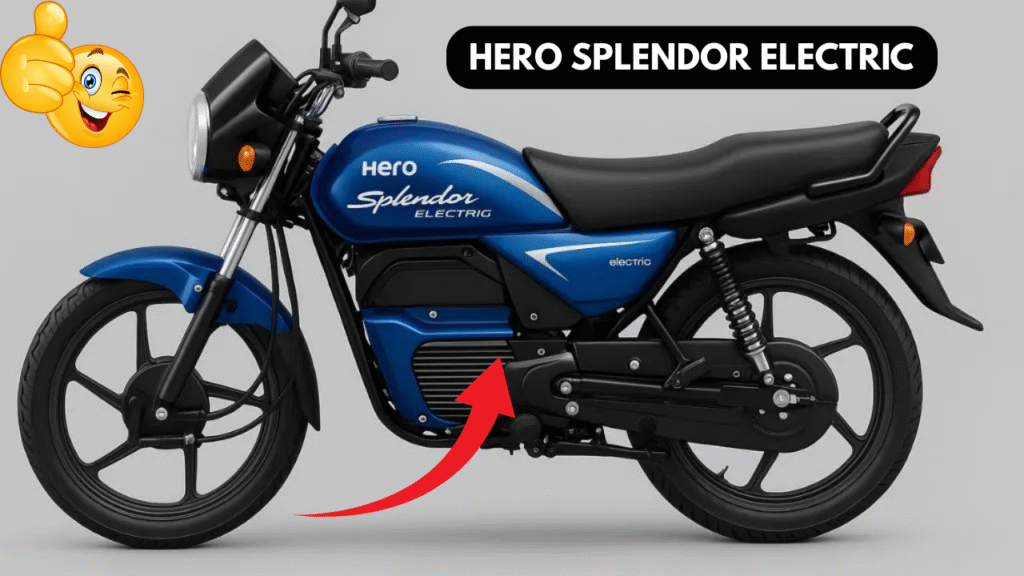The Hero Splendor Electric 2025, launched in India on March 27, 2025, transforms the country’s best-selling motorcycle into an eco-friendly commuter bike. Priced between ₹1.05 lakh and ₹1.30 lakh (ex-showroom), it competes with the Bajaj Chetak Electric, Ola S1 Pro, and TVS iQube. Targeting daily commuters, students, and delivery riders, it retains the Splendor’s reliability while offering zero-emission performance. Here’s a detailed review of its price, specifications, features, and performance in India as of August 31, 2025.
Classic Design with Modern Touches
The Hero Splendor Electric 2025 retains the iconic Splendor silhouette with a minimalist, commuter-friendly design, featuring a round LED headlamp, sleek tank-like storage compartment, and matte panels in Matte Black, Blue Accent, Silver, and Pearl White. Measuring approximately 2000 mm (L) x 720 mm (W) x 1050 mm (H) with a 785 mm seat height and 1235 mm wheelbase, it weighs 110 kg (kerb), ensuring nimble handling. The 17-inch alloy wheels with 80/100-17 tubeless tires and 130 mm ground clearance suit urban and semi-rural roads.

The 9.8-litre storage compartment (replacing the fuel tank) adds practicality, and the IP54 splash resistance handles light rain, though it lacks the IP67 rating of premium EVs like the Ola S1 Pro.
Practical and Tech-Equipped Cabin
The cockpit features a semi-digital instrument cluster displaying speed, battery level, range, and trip data, visible in daylight. Higher variants include a 4.59-inch LED screen with Bluetooth connectivity, real-time diagnostics, location tracking, and a USB charging port. Other features include LED lighting, side-stand engine cut-off, and combined braking system (CBS). The long, cushioned seat ensures comfort for solo or pillion riders, but the absence of smartphone app integration in base variants and no reverse mode are drawbacks compared to the TVS iQube.
Efficient Electric Performance
Powered by a 3 kW (4 bhp) BLDC mid-mounted motor with 255 Nm of torque, the Splendor Electric offers a top speed of 75 km/h and 0-40 km/h in ~7 seconds, ideal for city commuting. It uses a 4 kWh lithium-ion battery (removable), providing a 120 km range (standard) or 180 km with an optional 2 kWh battery pack. Charging takes 4-5 hours (standard 15A socket) or 1.5 hours for 80% with fast charging (11 kW). The bike offers three riding modes: Eco (max range), City (balanced), and Power (quick acceleration).
The telescopic front forks and twin rear shock absorbers are tuned for India’s bumpy roads, absorbing potholes well, though the suspension feels soft at higher speeds. The front disc and rear drum brakes with CBS provide reliable stopping power, but the lack of a front disc option in base variants is a miss.
Safety and Handling
Safety features include CBS, side-stand cut-off, and tubeless tires for better grip on wet roads. Higher variants add regenerative braking to extend range and a basic ABS for improved control. The lightweight 110 kg build and low center of gravity make it nimble in traffic, perfect for weaving through city streets or narrow lanes. While it lacks advanced ADAS, it targets a 3-4 star Bharat NCAP rating, sufficient for its commuter focus, though competitors like the Ola S1 Pro offer more tech.
Pricing and Availability
Priced at ₹1.05 lakh (base, ex-showroom, after FAME-II subsidy) to ₹1.30 lakh (top variant with extra battery), on-road prices in Delhi range from ₹1.15 lakh to ₹1.45 lakh, including RTO (₹8,000-10,000) and insurance (₹5,000-7,000). Available at Hero MotoCorp dealerships, ZigWheels, BikeDekho, and select online platforms, bookings opened on March 27, 2025, with a ₹5,000 token amount. Offers include ₹10,000-20,000 exchange bonuses for petrol Splendor owners, low-interest EMI (from ₹2,500/month, 9.8% interest, 36 months), and ₹5,000 discounts on select payment methods. Maintenance costs are low at ~₹2,000-3,000/year, with Hero’s 6,000+ service centers (EV-trained) ensuring support. Delivery times are 1-2 months, with high demand for Blue Accent and top variants. The warranty is 3 years/40,000 km (battery included), extendable to 5 years.
User Feedback and Drawbacks
Users praise the familiar Splendor design, 120-180 km range, low running costs (~25-30 paisa/km vs. ₹2-2.5/km for petrol), smooth and silent ride, and Hero’s reliability. The removable battery and nationwide service network ease range anxiety. Drawbacks include:
- Limited top speed (75 km/h), less suited for highways than the Bajaj Chetak (85 km/h).
- No advanced connectivity (e.g., smartphone app) in base variants.
- Soft suspension, less stable at high speeds.
- Small storage, compared to scooters like the Ola S1 Pro.
- No disc brake option in base variants, unlike TVS iQube.
Comparison with Competitors
The Hero Splendor Electric 2025 competes with:
- Bajaj Chetak Electric (₹1.15 lakh, 3.2 kW, 123 km range): Higher top speed but fixed battery.
- Ola S1 Pro (₹1.35 lakh, 11 kW, 195 km range): More powerful and tech-rich, but pricier.
- TVS iQube (₹1.17 lakh, 4.4 kW, 145 km range): Better features (reverse mode, touchscreen), but heavier (117 kg).
The Splendor Electric stands out for its affordability, lightweight build, and Hero’s service network, but it lags in power and tech compared to scooter rivals.
Final Thoughts
The Hero Splendor Electric 2025, launched on March 27, 2025, is a game-changer in India’s electric two-wheeler market, offering a 3 kW motor, 120-180 km range, and a lightweight 110 kg build. Priced from ₹1.05-1.30 lakh, it blends the Splendor’s iconic reliability with eco-friendly performance, ideal for daily commuters. While its range and low running costs impress, the limited top speed and basic features in lower variants are drawbacks. Backed by Hero’s vast service network, it’s a practical choice for India’s urban and semi-rural riders.